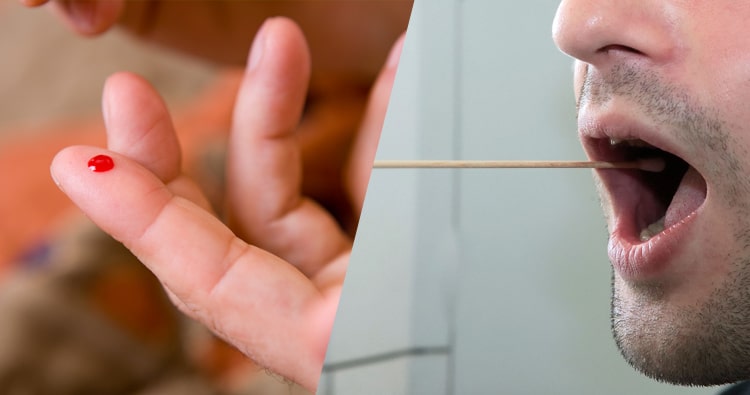There are two most popular methods for collecting DNA specimen in DNA test labs in India which are blood samples and buccal swabs. The results of DNA paternity/relationship in extracting DNA by swabs and blood samples are exactly the same, but there are small differences in how the two processes work. Both have their own advantages and disadvantages depending on your choice. Neither one is outright better than the other, it’s all depends upon the ability of the laboratory. Let’s explore how these two methods work.
How Swabs and Blood Samples Work
Persons providing DNA samples for paternity cases or relationship cases usually follow the normal procedures in DNA testing centers available around the country. DNA sample collected from a blood sample is exactly the same as DNA collected from your cheeks or buccal swabs. So when blood actually analyzed, it’s going to be exactly as accurate as the sample collected from your cheeks or buccal swabs.
Our clients usually have some questions before taking the test, we have tried and covered few most common questions below:-
What are the samples required for accurate DNA Test
For DNA testing any specimen can be used for DNA extraction like blood, buccal swab, routed hair, nails, semen stains, blood stains, skin and bones etc. but usually laboratories prefer blood or buccal swab sample for quality and accurate DNA test reports.
What is a Buccal swab and is it as accurate as blood?
A buccal swab is a way to collect DNA from the cells on the inside of a person’s cheek. Buccal swabs are a relatively non-invasive way to collect DNA samples for testing. Buccal means cheek or mouth. A buccal swab resembles a large cotton tip. It is used to collect cheek cells by rubbing the inside of the cheeks. It is as accurate as blood DNA test.
What About Blood Testing?
Blood is considered as most reliable sources of DNA. The procedure involves a small lancet that is used to lightly pierce a finger. A small drop of blood is then transferred to a collection card – that’s it. In terms of cost there is no difference if you choose buccal (cheek) swab testing or blood testing.
Depending on which procedure is used at the DNA testing center, a sample collection specialist verifies the person’s identity, photo, gets a signed consent and sample requisition form, swabs the inside of the mouth of the patient’s cheek, and then safely packs the DNA specimen into its provided envelops. The process of collecting blood samples works basically the same, but it is not quite as easy – a needle is inserted to draw your blood. Drowning of blood is an invasive and painful process and some persons are not comfortable with the blood. But now day’s blood can be collected with a simple finger prick and drown only 2 -3 drop of blood on bloating paper. This method is considered as easy and painless collection of blood samples. The process for both swab samples and blood samples is relatively straightforward, but there are indeed pros and cons for each that are discussed below:
Pros and Cons For Swab DNA Test Samples
Swab samples collections have a number of advantages:
- Easy and painless collection of sample, No needle is used, no puncture of the skin is necessary
- It’s a fast, non-invasive procedure, with no pain involved
- A common man can collect the sample, without specialization
- Scientists prefer the easier extraction process from a testing point of view
- Patients usually are more relaxed and less stressed about the DNA collection process
- Even cost effective too
- Easy transportation and storage
On the other side, the main disadvantages of swabs are:
- Contamination chances if not stored properly
- Reliably issue with the patient who are not aware
- Since the cells are not visible, there is no way to visually verify DNA is present
Pros and Cons for Blood DNA test Samples
Taking blood samples for DNA testing do have a few advantages of their own, including:
- Clean blood in proper tubes minimizes chances of contamination
- Fast and quick procedure of collection
- Easy and quick collection with simple figure prick
- Blood samples are visible, so visually verify DNA is present
- Cost effective collection
Blood samples do have disadvantages for patients seeking this type of DNA test:
- Needles puncture the skin – patients will feel some pain
- Specialized collector is required
- Conditions applied if patients gone through blood transfusion
- Storage and transportation is difficult as compare to swab
- Blood samples are fast to collect, but not as quick as swab samples
Conclusion
DNA test results will be exactly the same because DNA is the same in all nucleated cells of an individual’s body. DNA quantity and quality are expected to be high in a blood sample however this method often presents challenges. The invasive nature of a blood draw reduces donor compliance, increases the complexity and cost required for collection, shipping and storage of samples. Buccal swabs and blood samples both provide results with the same degree of accuracy. But since buccal swabs are easy and painless to collect, they are used in the majority of DNA paternity and relationship tests.

I have relatives that are twins, they recently underwent dna tests for one reason or another, come to find out that the twins do not have the same father. The tests were conducted twice to rule out any error. The tests came back the same. What are the odds of that happening?
What are the odds of dna tests of twins coming back that they do not have the same father?
Great blog! Thank you so much for this review. Here are get some very informative & importance info.